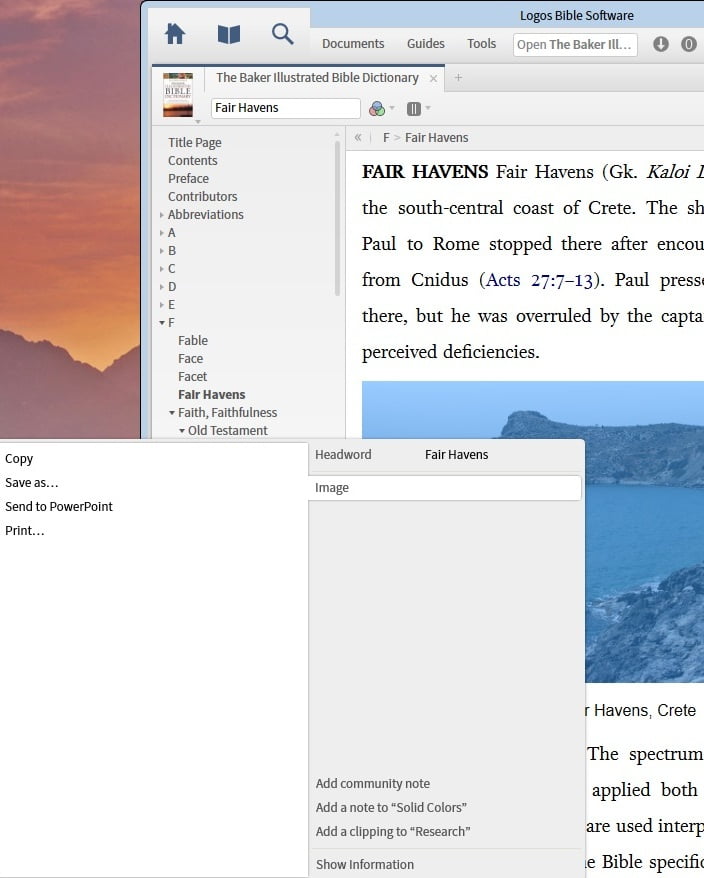Baker’s Baker Illustrated Bible Dictionary ( BIBD) was produced chiefly under the editorship of Tremper Longman, with Peter Enns (Old Testament) and Mark Strauss (New Testament) serving as associate editors. Logos Bible Software was kind enough to provide a copy of their release of the text for this review.
In the preface, the editors highlight the difficulty that
the Bible is not always easy to understand. The main message is clear enough, but much remains obscure. . . . The places named in the Bible are strange, and the number of people mentioned is virtually countless. We are distanced from both the Old and New Testaments by vast periods of time and culture. ( vii)
BIBD is intended to help address this situation with its “more than five thousand articles written by well over one hundred contributors” ( vii). Specifically as an illustrated dictionary, a good portion of the value the text intends to provide its users comes through the various visual supplements its entries provide. The text includes “1,700 full-color pages” ( Baker; Logos). Some of this color markup in the print version seems primarily to highlight particular textual elements for easier reference (e.g., 994). Consequently, not all of this information will be represented or represented in exactly the same way in the Logos version of the text, which follows the software platform’s coloration scheme conventions and may include, by default, still some further visual cues.

Fair Havens Image Export
Either in a physical print volume or in the Logos electronic format, the text’s main visual supplements include its more than 400 “visual illustrations, charts, pictures, and maps” in full color ( front cover, vii). With its articles and visual supplements, BIBD should prove “helpful . . . to support everyday Bible reading as well as to prepare for group Bible studies or to follow up on sermons, and for many other reasons” ( vii). Many visual elements do provide helpful information that is much easier expressed in images than in words. An additional benefit of the text in Logos is that images can be sent directly to PowerPoint or saved for use in other presentation platforms. Doing so may help save time in searching elsewhere for ways of showing what might be more difficult to describe with words.
A number of BIBD’s visual elements might be more useful in explaining the reception of rather than the background for particular biblical texts. For instance, the entry on Aaron depicts a carving of Moses and Aaron by Andreas Schultze (17th c.; 1), the entry on Eschatology includes a portion of Hans Memling’s (15th c.) Last Judgment( 518), and the entry on Ezekiel includes an Austrian carving (16th c.; 554). Even so, seeing options for understanding particular elements within the biblical text that differ from those to which one is generally accustomed can be helpful in showing up where contemporary readers’ unrealized assumptions may lie. The ease of searching BIBD in the Logos format may provide an additional benefit for finding and using BIBD’s visual elements where a given element might be relevant to multiple BIBD entries but not included with each.

‘BIBD
In Logos ( v. 5 Gold was used for this review), especially if BIBD is set as a preferred dictionary, lookups from Bibles are very simple. For discussion of and instructions about setting preferred resources, see the “Get the Most Out of Your Logos Library” webinar. Lookups work most directly from English Bibles through the right-click menu. In theory, when working with Bibles in other languages, users with access to the Bible Sense Lexicon can pull appropriate results from that resource and then choose one of the topic guide links to collate relevant entries from BIBD and other similar Logos resources. As of this writing, BIBD does not seem to display with other similar resources in the “Topic” section of the “Topic Guide.” To the best of my understanding, however, this behavior is simply a quirk for which a remedy is being investigated. In any case, it would make a nice feature enhancement if the software could pull through Bible Sense Lexicon information to build right-click menu preferred Bible dictionary entries when using, for instance, a Biblia Hebraica or Nestle-Aland text much it does when using an English Bible. Direct lookup by opening the resource and navigating its contents tree is, of course, also an option and perhaps the one to which I still tend to default most (since it most resembles pulling a book off the shelf and working through it to whatever relevant information).

BIBD and Logos Timeline
Another nice enhancement in the Logos version of BIBD are the timeline flags that appear with dates throughout the text. Clicking the flag will bring up the Logos timeline feature to show what else was happening at or around the time a given event is noted to have happened in BIBD. Clicking one of the timeline’s event bars then opens a fly-over menu with a list of resources that contain additional information about that event.
In short, BIBD seems to be very helpful as a basic reference text, and the visual elements it includes should be useful both for students and for teachers. Digital and print media both have their virtues, but BIBD plays very nicely in the Logos ecosystem. Some of the Logos platform’s supporting features provide helpful enhancements to BIBD, and having BIBD in one’s Logos library certainly helps foster the “network effect” that plays to the digital library’s strengths.